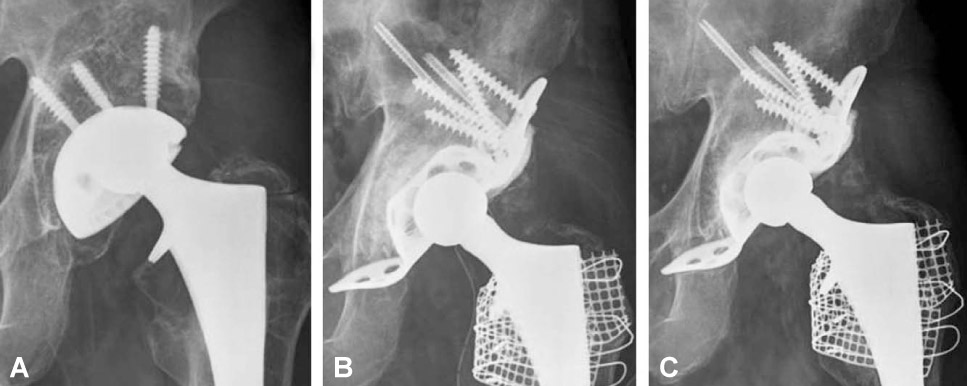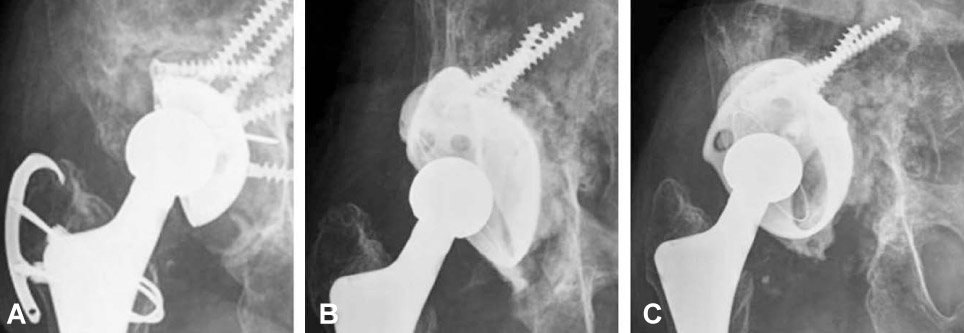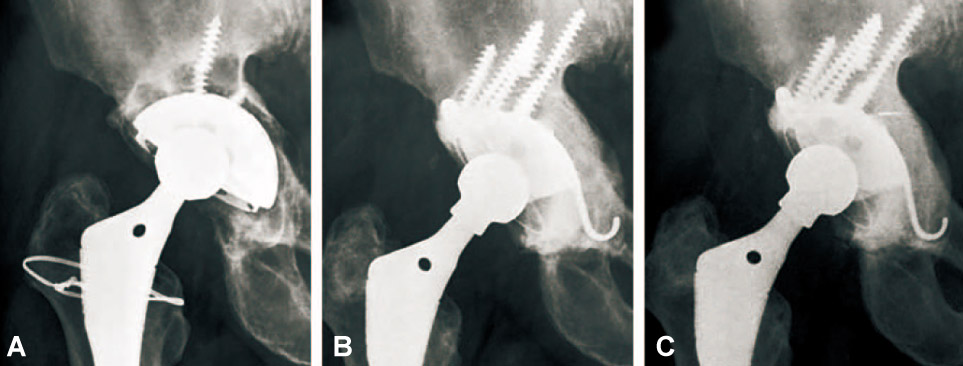J Korean Hip Soc.
2011 Sep;23(3):213-220. 10.5371/jkhs.2011.23.3.213.
Revision Total Hip Arthroplasty Using Acetabular Reinforcement Ring: Midterm Follow-up Result
- Affiliations
-
- 1Department of Orthopaedic Surgery, College of Medicine, Kyung Hee University, Seoul, Korea. yjcho@khmc.or.kr
- KMID: 2014888
- DOI: http://doi.org/10.5371/jkhs.2011.23.3.213
Abstract
- PURPOSE
To evaluate the clinical and radiographic outcomes of the revision total hip arthroplasty using the acetabular reinforcement ring.
MATERIALS AND METHODS
Thirty-six acetabular revisions were performed in 36 patients with use of the reinforcement ring and structural or morselized allograft, between 1997 and 2005, in thirty-six patients. According to the AAOS classification, thirty-four cases of acetabular defects were Ttype III, and two were Ttype IV. Mean follow-up period after surgery was 7.2 years.
RESULTS
The mean Harris hip score was 92.3, which was significantly increased compared with the preoperative score. (p<0.001). There were five failures: a case of aseptic loosening of Muller ring, two cases of infection (5.4%) and two cases of hip dislocation (5.4%). Graft incorporation and bone remodeling occurred successfully in all hips, but in the case of aseptic loosening in which the ring fixation had been inadequate at the time of surgery. The success rate was 91.7% with a mean follow-up of 7.2 years, if the cases of revision or loosening of the component were classified into failure cases.
CONCLUSION
Patients treated with acetabular revision with three kinds of reinforcement ring had reconstitution of periacetabular bone stock as well as good clinical and radiographic results. For the good results, the secure implant fixation during the surgery should be confirmed and we should completely understand the characters of the each kinds of reinforcement rings.
MeSH Terms
Figure
Reference
-
1. Haentjens P, Handelberg F, Casteleyn PP, Opdecam P. The Müller acetabular support ring. A preliminary review of indications and clinical results. Int Orthop. 1986. 10:223–230.2. Gill TJ, Sledge JB, Müller ME. The Bürch-Schneider anti-protrusio cage in revision total hip arthroplasty: indications, principles and long-term results. J Bone Joint Surg Br. 1998. 80:946–953.3. Berry DJ, Müller ME. Revision arthroplasty using an anti-protrusio cage for massive acetabular bone deficiency. J Bone Joint Surg Br. 1992. 74:711–715.
Article4. Schlegel UJ, Bitsch RG, Pritsch M, Clauss M, Mau H, Breusch SJ. Mueller reinforcement rings in acetabular revision: outcome in 164 hips followed for 2-17 years. Acta Orthop. 2006. 77:234–241.
Article5. Gill TJ, Siebenrock K, Oberholzer R, Ganz R. Acetabular reconstruction in developmental dysplasia of the hip: results of the acetabular reinforcement ring with hook. J Arthroplasty. 1999. 14:131–137.6. Gerber A, Pisan M, Zurakowski D, Isler B. Ganz reinforcement ring for reconstruction of acetabular defects in revision total hip arthroplasty. J Bone Joint Surg Am. 2003. 85-A:2358–2364.
Article7. Schatzker J, Wong MK. Acetabular revision. The role of rings and cages. Clin Orthop Relat Res. 1999. 369:187–197.8. Winter E, Piert M, Volkmann R, et al. Allogeneic cancellous bone graft and a Burch-Schneider ring for acetabular reconstruction in revision hip arthroplasty. J Bone Joint Surg Am. 2001. 83-A:862–867.
Article9. Schlegel UJ, Bitsch RG, Pritsch M, Clauss M, Mau H, Breusch SJ. Mueller reinforcement rings in acetabular revision: outcome in 164 hips followed for 2-17 years. Acta Orthop. 2006. 77:234–241.
Article10. Paprosky WG, Perona PG, Lawrence JM. Acetabular defect classification and surgical reconstruction in revision arthroplasty. A 6-year follow-up evaluation. J Arthroplasty. 1994. 9:33–44.
Article11. Winter E, Piert M, Volkmann R, et al. Allogeneic cancellous bone graft and a Burch-Schneider ring for acetabular reconstruction in revision hip arthroplasty. J Bone Joint Surg Am. 2001. 83-A:862–867.
Article12. Zehntner MK, Ganz R. Midterm results (5.5-10 years) of acetabular allograft reconstruction with the acetabular reinforcement ring during total hip revision. J Arthroplasty. 1994. 9:469–479.
Article13. Peters CL, Curtain M, Samuelson KM. Acetabular revision with the Burch-Schnieder antiprotrusio cage and cancellous allograft bone. J Arthroplasty. 1995. 10:307–312.
Article14. Bierbaum BE. Turner RH, Scheller AD, editors. Acetabular revision arthroplasty. Revision total hip arthroplasty. 1982. New York: Grune & Stratton;42–79.15. Korovessis P, Stamatakis M, Baikousis A, Katonis P, Petsinis G. Mueller roof reinforcement rings. Medium-term results. Clin Orthop Relat Res. 1999. 362:125–137.16. Oh I, Harris WH. Design concepts, indications, and surgical technique for use of the protrusio shell. Clin Orthop Relat Res. 1982. 162:175–184.
Article17. Eggli S, Müller C, Ganz R. Revision surgery in pelvic discontinuity: an analysis of seven patients. Clin Orthop Relat Res. 2002. 398:136–145.18. Paprosky WG, Magnus RE. Principles of bone grafting in revision total hip arthroplasty. Acetabular technique. Clin Orthop Relat Res. 1994. 298:147–155.19. Gross AE, Allan DG, Catre M, Garbuz DS, Stockley I. Bone grafts in hip replacement surgery. The pelvic side. Orthop Clin North Am. 1993. 24:679–695.20. Gross AE, Duncan CP, Garbuz D, Mohamed EM. Revision arthroplasty of the acetabulum in association with loss of bone stock. Instr Course Lect. 1999. 48:57–66.21. Korovessis P, Stamatakis M, Baikousis A, Katonis P, Petsinis G. Mueller roof reinforcement rings. Medium-term results. Clin Orthop Relat Res. 1999. 362:125–137.22. Haentjens P, de Boeck H, Handelberg F, Casteleyn PP, Opdecam P. Cemented acetabular reconstruction with the Muller support ring. A minimum five-year clinical and roentgenographic follow-up study. Clin Orthop Relat Res. 1993. 290:225–235.23. Siebenrock KA, Trochsler M, Sadri H, Ganz R. Hooked roof cup in revision of difficult loose hip prosthesis cups. Results after a minimum of 10 years. Orthopade. 2001. 30:273–279.
- Full Text Links
- Actions
-
Cited
- CITED
-
- Close
- Share
- Similar articles
-
- Acetabular Rebision Using Acetabular Reinforcement Ring and Allograft Impaction
- Revision of total Hip Arthroplasty Using Allogenic Bone Graft in Acetabular Deficiency
- Revision Total Hip Arthroplasty of an Acetabular Cup with Acetabular Bone Defects
- Early Failure of Acetabular Component after Total Hip Arthroplasty in Irradiated Hip
- Revision Total Hip Arthroplasty: Acetabular Cup





